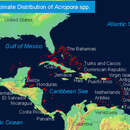en
names in breadcrumbs


"Branched Acropora colonies are abundant and show infinite variety, even within species. Massive or encrusting colonies are rarely seen. Among the branched forms it is possible to recognize staghorns, clusters, plates and tables, and between them lie many intermediates. The branches of staghorn Acropora are usually 10 cm in length and may be 1.5 cm or more in width. They arise from a single main stem and rarely fuse. Clusters consist of profusely divided branches that form a thicket or branchlets. The latter are usually less than 5 mm in diameter and may interlock. Plates and tables have a short, stout stem attached by a spreading base. Branches arise from the top of the stem and spread in a horizontal rather than vertical direction, often fusing together. The closely set and interlocking branches form a roughly circular plate sometimes two or three meters in diameter. Young colonies do not fall into these categories because virtually all are encrusting or knobby. Acropora species are among the most brightly colored corals on the reef. Often the are blue, green, purple or pink, sometimes cream, yellow, brown or red. The branch tops are usually paler. Each polyp has six or 12 slender tentacles that when extended may be 3 or 4 mm long. They are often white. Acropora is easily recognized by the shape and general characteristics of the corallites. In branched colonies the corallites are of two types. At the branch tip is a symmetrical and usually larger axial corallite, and down the elngth of the branches are many smaller asymmetrical. These radial corallites have been budded off from the axial corallite, and any of the radial poylps have the capacity to take up this reproductive role. Lobed or semi-massive colonies have scattered axial corallites, but they are scarcely more prominent than the other. Corallites are round in cross section and protrude several millimeters from the surface. Radial corallites often protrude only on one side because they lie at an angle to the branch. The size of corallites varies even in a single specimen, but their width is around 1.5 to 2.5 mm. It is common for the corallite wall to be fairly thick and the fossa relatively small. Calices are often crowded with the walls touching." (Dr. Elizabeth M. Wood, 1984).